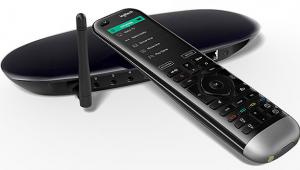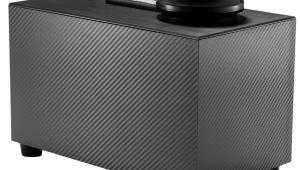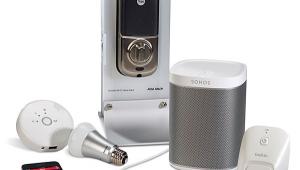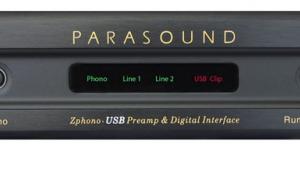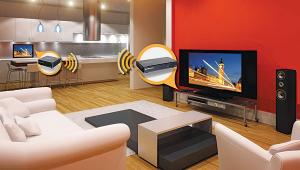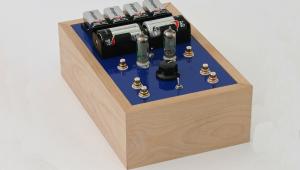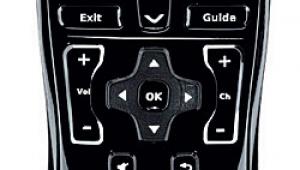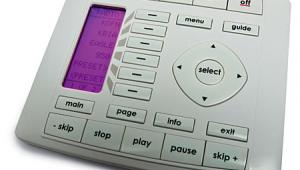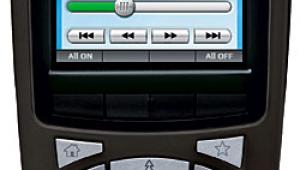Clark Synthesis Platinum 1 Transducer
From the time movies first emerged as a pastime, filmmakers and theater owners have tried to come up with ways to make the movie experience more and more realistic. The picture (other than size) couldn't change, so they tried other ways. Some, like the Smellorama, didn't work. Others, like multichannel sound, did. Moving from one channel to six or eight channels, most people would think, "I'm surrounded by sound. What else is there?" What all, or at least most, systems lack is the ability to touch you—to literally touch you. Clark Synthesis' line of transducers aims to change that with tactile sound.

To enjoy a little rump shaking, bolt the Platinum 1 to the bottom of your sofa or chair. You can also create a riser if you don't want to drill holes in your furniture.
What, you may ask, is a transducer? By definition, it's a speaker; however, a Clark transducer is not just a speaker. Looking like a black flying saucer, it bolts onto your sofa or chair. When powered, it vibrates . . . and vibrates everything it's attached to. This means you, your sofa, your floor, your dog—whatever is in contact with what the transducer is in contact with. Until now, tactile sound was thought to only be felt at high sound pressure levels, usually from a subwoofer.
Clark Synthesis' main line of home transducers consists of four models that are identical-looking but that vary greatly in sound and tactile output. The TST 229 is the baby of the bunch, handling up to 100 watts and moving 1.6 pounds per watt. The next size up is the TST 329, with 135 watts moving 2.8 pounds per watt. Until recently, the TST 3710 was the flagship model, with 135 watts moving 3.5 pounds per watt, but that honor now falls on the Platinum 1, with its 135 watts moving 6.9 pounds per watt. This means that, at full capacity, it can output 931.5 pounds of chair-shaking power. Although more expensive, the Platinum 1 is by far the most fun of all the models. Unless you have a very lightly cushioned couch, the rather weak TST 229 really isn't the way to go. Clark recommends two of any unit in each couch, hooked up in stereo so that you can get a pan of vibration across your bottom. For this review, we only used one.
The detailed instructions were easy to follow. In just a few steps, you can mount the transducer on just about any seating surface. There are also directions for mounting it on your deck or in your car. If you don't want to drill holes in your furniture, the manual includes tips for creating a riser for the transducer. Those of you who have fallen to the IKEA nesting instinct might want to look into this option, as you will have to drill holes in your furniture (although they won't be visible). The best place to mount the transducer seems to be on any wood crossbeam in the middle of the piece of furniture. Unseen, but not unfelt.
The installation manual advises running the transducer off your main left and right preamp outputs. This is easier said than done, as some receivers and pre/pros only have a fixed line-level signal (i.e., tape/record) output. Running it to a separate amp will do very little unless your amp has a volume control. For those who have a variable-level output (i.e., preamp outs), just hook it up and have fun. I took the output from the left and right preouts, combined them, and ran them to another receiver. This setup let me have independent volume control over the transducer and is probably the best option for most people.
During the opening scenes of Titan A.E., the Platinum 1 did a great job of creating realistic vibrations for helicopters roaring by and, of course, Earth blowing up. However, because it was running off the left and right channels on a Dolby Digital system, it didn't rumble during effects that were only sent to the LFE channel. Also, because the transducer has such a high frequency response, it vibrated during effects that wouldn't vibrate you in real life, such as voices and some musical instruments. I like strings, but my sofa doesn't usually tremble to violins, no matter how loud (or awful) they are.

The manual suggests that you connect the transducer to your main left and right preouts, but we got more bang for our butt when running it off the LFE signal.
When I fed the transducer exclusively from the LFE channel, it seemed like a whole new world had opened up. Instead of a rather constant mild vibration with a few peaks of real rumble, the transducer now had a signal that it could really run with. Explosions rocked the sofa, your fearless reviewer, and the floor—the latter causing my downstairs neighbors to repeatedly bang on their ceiling. What's amusing is that I was listening to the movie at a fairly low volume. The perceived volume is much louder, of course, creating vibrations previously only caused by high SPLs. After I got used to the Platinum 1, I had to resist the temptation to watch all my DVDs again just to see (and feel) how different they were. I'm sure my downstairs neighbors would have loved that. I highly recommend using some kind of rubber feet on your sofa to isolate it from the floor.
Of course, it took well over an hour to set up the transducer and get it working properly. Even then, I was fiddling with it throughout most of the demo movie. The Platinum 1 really needs its own separate volume control, as it needs to be set differently for each viewer and for each movie. What this product ought to have is some sort of EQ or crossover. While running it off the LFE signal was far superior to running it off the main speaker outs, there were still a few effects from the left and right channels that weren't low enough to be only in the LFE channel, even with my speakers set to small. A low-pass filter set to cross over the low end of the main channels combined with the LFE would be perfect. Adding something like this would give you the ability to dial-in your favorite settings. AudioControl makes a product called the Richter Scale that does this pretty well, and several other manufacturers also make products like this. Unfortunately, these usually cost close to $300 each. Clark makes a few other items that would probably do the job (and are fortunately much less expensive).
There were also some features that were a little bothersome. Our test unit only came with 1 foot of speaker wire. Clark does say that they can put on as much as you need, so keep in mind that you might need more. One other annoyance was my fault: The manual says not to use the transducer to tighten itself on the mounting bolts. Trust me, heed this warning.
Overall, this is a very fun piece of equipment. If you have a complete home system and are looking for something to spice it up, this is definitely the product for you. I can think of very few products that add this much to a system for so little relative cost. (Sure, a CRT projector is this much fun, but really—$25,000 versus the $700 cost of the Clark.) There are many other uses for this product that are too numerous to go into, but feel free to check out the company's Website. I was skeptical at first; however, once I got used to the Platinum 1, I couldn't imagine my system without it.
Highlights
• A fun addition to any home theater
• Will work with just about any system
• Did we mention fun?

- Log in or register to post comments

